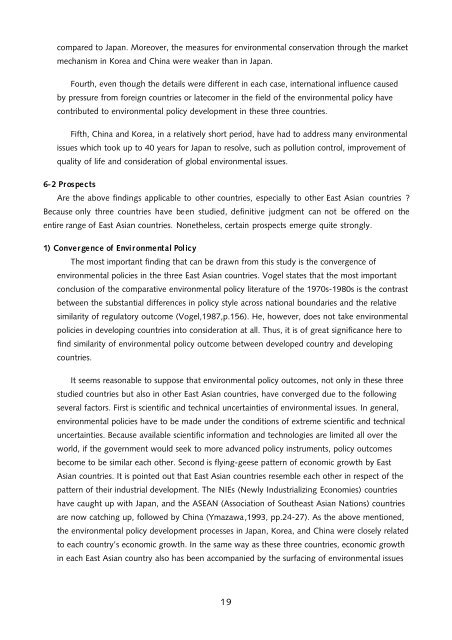Untitled - UNU-IAS
Untitled - UNU-IAS
Untitled - UNU-IAS
Create successful ePaper yourself
Turn your PDF publications into a flip-book with our unique Google optimized e-Paper software.
compared to Japan. Moreover, the measures for environmental conservation through the market<br />
mechanism in Korea and China were weaker than in Japan.<br />
Fourth, even though the details were different in each case, international influence caused<br />
by pressure from foreign countries or latecomer in the field of the environmental policy have<br />
contributed to environmental policy development in these three countries.<br />
Fifth, China and Korea, in a relatively short period, have had to address many environmental<br />
issues which took up to 40 years for Japan to resolve, such as pollution control, improvement of<br />
quality of life and consideration of global environmental issues.<br />
6-2 Pros pects<br />
Are the above findings applicable to other countries, especially to other East Asian countries ?<br />
Because only three countries have been studied, definitive judgment can not be offered on the<br />
entire range of East Asian countries. Nonetheless, certain prospects emerge quite strongly.<br />
1) Convergence of Environment al Policy<br />
The most important finding that can be drawn from this study is the convergence of<br />
environmental policies in the three East Asian countries. Vogel states that the most important<br />
conclusion of the comparative environmental policy literature of the 1970s-1980s is the contrast<br />
between the substantial differences in policy style across national boundaries and the relative<br />
similarity of regulatory outcome (Vogel,1987,p.156). He, however, does not take environmental<br />
policies in developing countries into consideration at all. Thus, it is of great significance here to<br />
find similarity of environmental policy outcome between developed country and developing<br />
countries.<br />
It seems reasonable to suppose that environmental policy outcomes, not only in these three<br />
studied countries but also in other East Asian countries, have converged due to the following<br />
several factors. First is scientific and technical uncertainties of environmental issues. In general,<br />
environmental policies have to be made under the conditions of extreme scientific and technical<br />
uncertainties. Because available scientific information and technologies are limited all over the<br />
world, if the government would seek to more advanced policy instruments, policy outcomes<br />
become to be similar each other. Second is flying-geese pattern of economic growth by East<br />
Asian countries. It is pointed out that East Asian countries resemble each other in respect of the<br />
pattern of their industrial development. The NIEs (Newly Industrializing Economies) countries<br />
have caught up with Japan, and the ASEAN (Association of Southeast Asian Nations) countries<br />
are now catching up, followed by China (Ymazawa,1993, pp.24-27). As the above mentioned,<br />
the environmental policy development processes in Japan, Korea, and China were closely related<br />
to each country’s economic growth. In the same way as these three countries, economic growth<br />
in each East Asian country also has been accompanied by the surfacing of environmental issues<br />
19

















